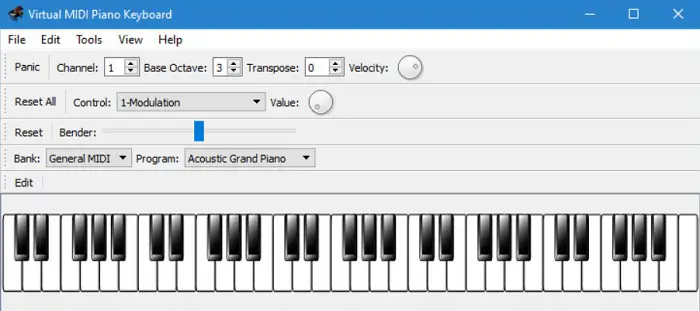
According to California-based blacker TheTrustedComputer, black MIDI was intended as more of a remix style than an actual genre, and derived from the idea of "bullet hell" shoot 'em up games, which involved "so many bullets at a time your eyes can't keep up." Black MIDI has also been considered the digital equivalent, as well as a response, to composer Conlon Nancarrow's use of the player piano which also involved experimenting with several thick notes to compose intricate pieces without hands. The term "Black MIDI" is derived from how there are so many notes in each piece that the score would look nearly black (or would look really black) on traditional sheet music. Some of them, like Jason, record the MIDI files at a slow tempo and then speed the footage in video-editing to avoid RAM and processing issues.
Virtual midi piano keyboard youtube software#
Blackers around the world have used software such as Synthesia, FL Studio, SynthFont, Virtual MIDI Piano Keyboard, Piano From Above, MIDITrail, vanBasco Karaoke Player, Ultralight MIDI Player (a Java program), Zenith, MAMPlayer, Music Studio Producer, Singer Song Writer, Tom's MIDI Player, TMIDI, and Timidity++ to create and play Black MIDIs.

Įnglish-language blackers have formed collaboration groups, such as the Black MIDI Team, where they make MIDI files and visuals together so they can be uploaded online sooner. Due to the nature of their creation and their sheer size, they are unable to be played back and recorded. The three largest black MIDIs are "Armageddon v3", "TheTrueEnd", and "Ashes", all of which contain the maximum number of notes allowed in the MIDI standard (about 93 trillion).

Despite this increased computer storage, there are still Black MIDI files that could cause an operating system to slow down. The number of notes and file sizes that could be played back have grown with the rising amount of processing and 64-bit programs computers are able to handle, and while Black MIDIs of Japanese video game music and anime are still common, the genre has also begun spilling into modern-day pop songs, such as " Wrecking Ball" by Miley Cyrus. The end of the title of many Black MIDI videos displays how many notes are in the piece. The first of these tracks to reach the million-note mark was that of "Necrofantasia" from Touhou Project video game Perfect Cherry Blossom, arranged by TheTrustedComputer. They also formed the sites Guide to Black MIDI and Official Black MIDI Wikia that introduced and set the norm of Black MIDI. The popularity of Black MIDI transitioned into Europe and the United States due to a video of a composition uploaded to YouTube by user Kakakakaito1998 in February 2011, and shortly thereafter, blackers from around the world began pushing limits of the style by making compositions with notes increasing into the millions and using an enormous number of colors and patterns to match the complexity of the notes.
Virtual midi piano keyboard youtube tv#
The Black MIDI community in Japan vanished quickly because, according to Jason Nguyen (owner of the channel Gingeas), the group was "analogous to those TV shows where there's a mysterious founder of a civilization that is not really known throughout the course of the show". They were created with MIDI sequencers such as Music Studio Producer, and Singer Song Writer, and played through MIDI players such as MAMPlayer and Timidity++.

In its beginning years, Black MIDIs were represented visually with traditional, two-stave piano sheet music, contained a number of notes only in the thousands.

It was uploaded to the site Nico Nico Douga in 2009, and public awareness of Black MIDI started to spread from Japan to China and Korea in the following two years. Owen Was Her?", an extra boss theme from the Touhou Project shooter video game The Embodiment of Scarlet Devil. īlack MIDI was first employed in Shirasagi Yukki at Kuro Yuki Gohan's rendition of "U.N. Frank Zappa also wrote a dense and extremely difficult composition called " The Black Page". Another precursor to black MIDI is Circus Galop, a player piano composition written by Canadian virtuoso Marc-Andre Hamelin, featuring complex and impossible arrangement with up to 21 notes played simultaneously. Though the two are unrelated in origin, the concept of impossible piano existed long before black MIDI, manifesting itself within Conlon Nancarrow's work involving player pianos where he punched holes in piano cards, creating extremely complex musical compositions in the same impossible, unplayable spirit of black MIDI.


 0 kommentar(er)
0 kommentar(er)
